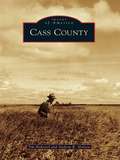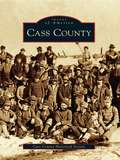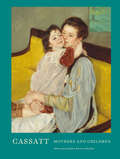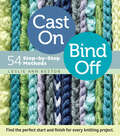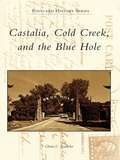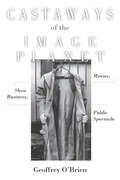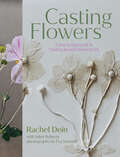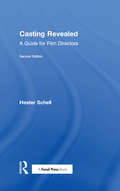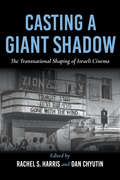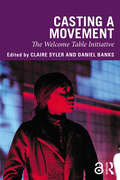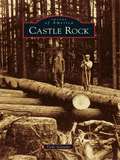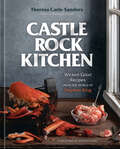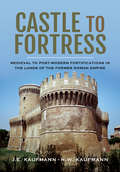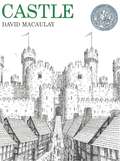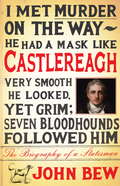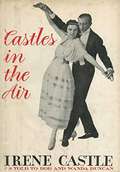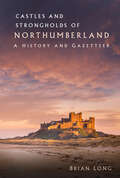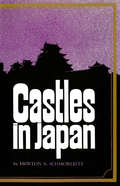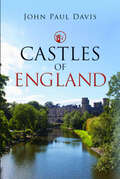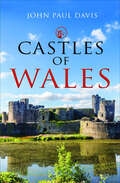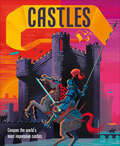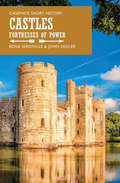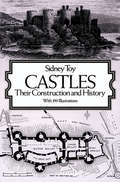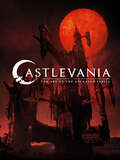- Table View
- List View
Cass County (Images of America)
by Tim Hoheisel Andrew R. NielsenCass County is flanked on its eastern border by the Red River of the North. Created by retreating glaciers, Cass County is known for its exceptionally flat topography and fertile soils. Archaeological evidence indicates that the county was home to Paleo-Indian groups as far back as 9,000 years ago. More recently, many different Native American nations foraged and hunted bison in the region. Dakota Territory was created in 1861, and Cass County was organized in 1873 with Fargo recognized as the county seat in 1875. The county is named for George Washington Cass, a former president of the Northern Pacific Railroad, which entered the county in 1872. Cass County is famous for agriculture and its bonanza farms, enormous commercial wheat farms unique to the Red River valley from the 1870s to the 1890s.
Cass County: Scenes And Events At The Mouth Of Eel On The Historic Wabash; With Papers Read Before The Cass County, Indiana, Historical Society At Its Spring Meetings 1907 (Images of America)
by Cass County Historical SocietyIn 1849, the Leech Lake Agency for the Ojibwa peoples was established southwest of Agency Bay on Leech Lake. A government trail wound its way north through the wilderness from Fort Ripley to the agency. The establishment of this trail encouraged exploration and settlement of the area that became Cass County. Fur traders, explorers, and missionaries were followed by the lumber industry. The Ojibwas ceded their lands, which went up for public auction in the 1870s, and the logging companies purchased thousands of acres of these lands. By 1895, the Minnesota Logging Company was in the northern part of the county and built the Brainerd, Northern and Minnesota Railroad, which was sold to the Minnesota and International, which was the first railroad in Cass County. Small towns were platted out by town site companies and quickly settled by immigrants and others seeking new opportunities. Cass County presently has 15 villages and 50 townships. Tourism was first introduced into the county when a trainload of 300 tourists from St. Cloud arrived for a weekend of fishing on Leech Lake. Tourism is the county's number one industry today.
Cassatt: Mothers and Children
by Sue Roe Judith A. BarterMary Cassatt's tender and profound paintings redefined portraiture and broke down barriers for women in art—both as artists and as subjects. This collection focuses on Cassatt's insightful portrayal of women and children living their everyday lives. Fifty magnificent images cover the scope of Cassatt's work, from her early interest in Japanese woodblocks all the way to her exploration of Modernist techniques. Two essays contextualize her as a pioneering female artist and as the American face of Impressionist painting. This is a luminous, robust, and timely celebration of an artist with a unique legacy. A luxurious textured case makes the book a meaningful gift for mothers, feminists, and art lovers.
Cast On, Bind Off: 54 Step-by-Step Methods; Find the perfect start and finish for every knitting project
by Leslie Ann BestorDiscover the perfect beginning and ending for every knitting project! Detailed instructions for each technique are combined with step-by-step photography to help you create edges that are tighter, looser, stretchier, or lacier. No matter what you’re knitting, Leslie Ann Bestor has the cast on and bind off that will give your project the perfect edge.
Cast of Riverdale: Issue #3 (Scoop! The Unauthorized Biography #3)
by C. H. MitfordIntroducing a new series of unauthorized biographies on the world's biggest names and rising stars in entertainment, sports, and pop culture! Complete with quizzes, listicles, trivia, and a full-color pull-out poster of the star, this is the definitive collection to get the full Scoop! and more on your favorite celebrities.Riverdale has got it all: • Dangerous gangs. Check. • Murder mysteries. Plenty. • High-school drama. *Side eye roll* • Awkward love triangles. Where do we even begin? While we can all agree Hiram is LITERALLY the worst, one question remains: Will Jughead ever take off his beanie???Get the full Scoop! and more on your favorite cast's on-screen drama, their IRL relationships, and to find out who your spirit character is...Are you a Betty Cooper or a Veronica Lodge? An Archie or Jughead? Or maybe you're a Hiram after all?
Castalia, Cold Creek, and the Blue Hole
by Glenn C. KuebelerOver the past hundreds of years, trillions of gallons of pure, crystal clear water have flowed through the subterranean aquifer system under Huron and Erie Counties in Ohio. The water comes to the surface at the Castalia Springs and the famous Blue Hole, both popular tourist destinations receiving thousands of visitors. Artificial canals were dug in the early 1800s to convey the water northward from Castalia to Venice to power flour mills, subsequently transforming the muskrat marshes into rich farmland. Water was also piped to Sandusky for brewing Crystal Rock beer. The fastmoving waters of Cold Creek provided a favorable environment for raising game trout. This resulted in the establishment of several private troutfishing clubs renowned throughout Ohio. Castalia, Cold Creek, and the Blue Hole offers a pictorial journey through the history of Cold Creek from Seneca Caverns near Bellevue to the carp pens in Venice on Sandusky Bay.
Castaways of the Image Planet: Movies, Show Business, Public Spectacle
by Geoffrey O'BrienOne of our best cultural critics here collects sixteen years' worth of essays on film and popular culture. Topics range from the invention of cinema to contemporary F-X aesthetics, from Shakespeare on film to Seinfeld, and we include essays on 30's screwball comedies, Hong Kong Martial Arts movies, to the roots of spy movies and the televising of Clinton's grand jury testimony.O'Brien emphasizes the unpredictable interactions between film as a medium apt for expressing the most private dreams and film as the mass literature of the modern world. Several of the pieces are profiles of individual actors or directors-Orson Welles, Michael Powell, Ed Wood, Marlon Brando, Alfred Hitchcock, Dana Andrews, The Marx Brothers, Bing Crosby-whose careers are probed to look for the point where obsession meets public myth-making.
Casting Flowers: A Step-by-Step Guide to Creating Beautiful Botanical Art
by Rachel DeinArtist Rachel Dein introduces readers to botanical bas-relief, an innovative and exciting technique developed by the author, one that anyone—gardener, parent, weekend crafter, or artist—can try at home in every season. Casting Flowers introduces botanical bas-relief as a rewarding method that encourages even the most basic beginners to revel in the ability to record a plant's texture, pattern, and delicacy in fine detail, creating compositions as small as a single stem or as complex as a field of wildflowers. All it takes is clay, flower, plants, and plaster. Artists can leave a finished piece bare and elegant, or experiment with painting on its surface, bringing the plants to life in color. From small plaster tiles featuring a single flower portrait to large panels that suggest an entire garden full of blooms, botanical castings reflect every artist&’s desire to capture the ephemeral in nature. A meditative activity that encourages artists to explore their gardens and natural spaces for materials, botanical bas-relief teaches readers how to track the progress of the seasons, immortalizing the plants at the moment when they are most alive. With accessible instructions, stunning photography of the process from start to finish, and insights into the artist's own garden, readers will discover: ·Step-by-step guidance on the tools and equipment needed to set up a simple workspace ·What plants work best in botanical casts, and which to avoid ·How to arrange flowers and stems to make well-balanced artistic compositions ·Tips on creating unique pieces of artwork as mementos of a season or records of special occasions
Casting Revealed: A Guide for Film Directors
by Hester SchellCasting is an essential component of any film or video project, but the core skill-set needed to cast effectively is little understood. Casting Revealed: A Guide for Film Directors is a straightforward manual on the art and craft of casting. Here, director Hester Schell offers her insider perspective on casting workflows, industry standards, finding actors, running auditions, what to look for in a performance, contracts, and making offers. This new edition has been updated with fresh interviews with casting directors, full color head shots, new information about online video submissions, and a companion website featuring forms, contracts, and sample scenes for auditions. Gain a fuller understanding of the misunderstood art and craft of casting actors for film and video production. Learn to find the right actors for any production, run auditions, interview actors, effectively judge performances and video submissions, evaluate suitability for a role, discover what it is you need from an actor, view headshots, draft contracts, make offers, and navigate current industry standards, unions, and procedures. This new edition has been updated to include full color sample head shots, new content on online video submissions, listings of casting wesbites, film resources, and film commissions and a companion website featuring interviews with celebrated casting directors from New York, Portland, Boston and Austin, necessary forms, sign-in sheets, contracts, and sample scenes for auditions.
Casting a Giant Shadow: The Transnational Shaping of Israeli Cinema (New Directions in National Cinemas)
by Mary N. Layoun Yaron Peleg Yaron Shemer Tobias Ebbrecht-Hartmann Zachary Ingle Raz Yosef Boaz Hagin Yael Munk Neta Alexander Ariel M. Sheetrit Ohad Landesman Shmulik Duvdevani Joshua Beaty Nava Dushi Pablo Utin Julie Grimmeisen Anat DanFilm came to the territory that eventually became Israel not long after the medium was born. Casting a Giant Shadow is a collection of articles that embraces the notion of transnationalism to consider the limits of what is "Israeli" within Israeli cinema. As the State of Israel developed, so did its film industries. Moving beyond the early films of the Yishuv, which focused on the creation of national identity, the industry and its transnational ties became more important as filmmakers and film stars migrated out and foreign films, filmmakers, and actors came to Israel to take advantage of high-quality production values and talent. This volume, edited by Rachel Harris and Dan Chyutin, uses the idea of transnationalism to challenge the concept of a singular definition of Israeli cinema. Casting a Giant Shadow offers a new understanding of how cinema has operated artistically and structurally in terms of funding, distribution, and reception. The result is a thorough investigation of the complex structure of the transnational and its impact on national specificity when considered on the global stage.
Casting a Movement: The Welcome Table Initiative
by Claire Syler Daniel BanksCasting a Movement brings together US-based actors, directors, educators, playwrights, and scholars to explore the cultural politics of casting. Drawing on the notion of a "welcome table"—a space where artists of all backgrounds can come together as equals to create theatre—the book’s contributors discuss casting practices as they relate to varying communities and contexts, including Middle Eastern American theatre, disability culture, multilingual performance, Native American theatre, color- and culturally-conscious casting, and casting as a means to dismantle stereotypes. Syler and Banks suggest that casting is a way to invite more people to the table so that the full breadth of US identities can be reflected onstage, and that casting is inherently a political act; because an actor’s embodied presence both communicates a dramatic narrative and evokes cultural assumptions associated with appearance, skin color, gender, sexuality, and ability, casting choices are never neutral. By bringing together a variety of artistic perspectives to discuss common goals and particular concerns related to casting, this volume features the insights and experiences of a broad range of practitioners and experts across the field. As a resource-driven text suitable for both practitioners and academics, Casting a Movement seeks to frame and mobilize a social movement focused on casting, access, and representation.
Castle Rock
by Vicki SelanderEarly travelers coming up the Cowlitz River saw a large rock formation next to the river, which they named Castle Rock. It was here, nestled between the Willapa Hills and the Cascade Mountains, that William and Eliza Huntington made their homestead in 1852. Theirs and several other early land grants make up what is now the site of Castle Rock, as well as nearby homes and farms. Descendants of many early pioneer families continue to live in Castle Rock, including Pyle, Jackson, Merrill, Dougherty, Whittle, Studebaker, and others. The town and its people have survived a series of natural disasters in the 20th century, including floods, an earthquake, a Pacific hurricane, and the eruption of Mount St. Helens, each time picking up the pieces of their lives and rebuilding. With the virtual collapse of the timber industry, Castle Rock is now beginning to find its identity and ability to prosper in the 21st century.
Castle Rock Kitchen: Wicked Good Recipes from the World of Stephen King [A Cookbook]
by Theresa Carle-SandersExplore 80 classic and modern recipes inspired by Stephen King&’s Maine, featuring dishes from the books set in Castle Rock, Derry, and other fictional towns—with a foreword from the legendary author himself.Castle Rock Kitchen is an immersive culinary experience from the mouthwatering to the macabre, with gorgeous, moody photographs to transport Stephen King fans to kitchen tables, diners, and picnic blankets across Maine. Recipes ranging from drinks to dessert (and every course in-between) are inspired by meals and gatherings from the more than forty novels and stories set in King&’s Castle Rock multiverse—a darker, more gothic version of the Maine most are familiar with. The eighty professionally developed dishes use plenty of local, down-home ingredients such as fresh seafood, potatoes, wild blueberries, and maple syrup, plus some delicacies from away—here are just a few:• Breakfast: Pancakes with the Toziers (It), Dog Days French Toast (Cujo)• Dinner: One-Handed Frittata (Under the Dome), Killer Mac and Cheese (&“Gramma&”)• Supper: Blue Plate Special (11/22/63), Whopper Spareribs (The Tommyknockers)• Fish and Seafood: Crab Canapés (Pet Sematary), Moose-Lickit Fish & Chips (The Colorado Kid)• Vegetarian: Wild Mushroom Hand Pies (Bag of Bones), Holy Frijole Enchiladas (Elevation)• Baking and Sweets: Hermits for the Road (The Long Walk), Blueberry Cheesecake Pie (&“The Body&”)• Drinks and Cocktails: Homemade Root Beer (Carrie), Deadly Moonquake (&“Drunken Fireworks&”)With a foreword written by Stephen King and story excerpts that connect the recipes to the books that inspired them, Castle Rock Kitchen delivers frightfully good food and drink.
Castle to Fortress: Medieval to Post-Modern Fortifications in the Lands of the Former Roman Empire
by H. W. Kaufmann J. E. KaufmannThe authors of Castrum to Castle trace the &“evolution of defensive architecture at the turn of the late Middle Ages and the beginning of the Renaissance.&” —Old Barbed Wire Blog Across western Europe, the long tradition of castle-building took on its most sophisticated form in the later Medieval period and then, in response to the development of gunpowder weapons, it underwent a fundamental change—from castle to fortress. This, the second volume of a highly illustrated new study of medieval fortification, gives a fascinating insight into the last great age of castles and the centuries of violence and conflict they were part of. It traces the advances made between the twelfth and the fifteenth centuries, looking in particular at the form these fortifications took in contexts as different as Italy, Wales, France and the Iberian Peninsula. Many would regard this period in the history of castles as the classic age. It was followed by a phase of relative decline as the conditions of warfare changed and castles had to be adapted to cope with cannon. The conventional castle gave way to new styles of fortification. But, as the authors demonstrate, they were still essential factors in military calculations and campaigns—they were of direct strategic and tactical importance wherever there was an attempt to take or hold territory. &“A fascinating treatise on the way such buildings were modified to provide protection from growing threats.&” —Books Monthly
Castle: Revised And In Full Color
by David MacaulayThe word itself conjures up mystery, romance, intrigue, and grandeur. What could be more perfect for an author/illustrator who has continually stripped away the mystique of architectural structures that have long fascinated modern man? <P><P> With typical zest and wry sense of humor punctuating his drawings, David Macaulay traces the step-by-step planning and construction of both castle and town.
Castlereagh
by John BewThe best political biography of the year' Jonathan Sumption, Spectator'Wonderful . . . A Life so nearly complete it need never be written again' Ferdinand Mount, Times Literary SupplementBy the author of the Orwell Prize-winning Citizen ClemDamned in coruscating verse by Shelley and Byron, his coffin hissed at during his funeral, Lord Castlereagh has one of the blackest reputations in British history. But as John Bew shows, this is but a half-drawn portrait. His gripping biography reveals a shy, inarticulate but passionate man; a towering political figure of implacable principles who redrew the map of Europe, fought a duel with a cabinet colleague and would tragically take his own life amid rumours of scandal and madness.
Castles In The Air
by Irene CastleTells the story of Vernon and Irene Castle, who popularized modern ballroom dancing and set fashion trends in the years before the First World War.“Vernon and Irene Castle were a husband-and-wife team of ballroom dancers and dance teachers who appeared on Broadway and in silent films in the early 20th century. They are credited with reviving the popularity of modern dancing. Castle was a stage name: Vernon (2 May 1887 – 15 February 1918) was born William Vernon Blyth in England. Irene (7 April 1893 – 25 January 1969) was born Irene Foote in the United States.The couple reached the peak of their popularity in Irving Berlin's first Broadway show, Watch Your Step (1914), in which they refined and popularized the Foxtrot. They also helped to promote ragtime, jazz rhythms and African-American music for dance. Irene became a fashion icon through her appearances on stage and in early movies, and both Castles were in demand as teachers and writers on dance.After serving with distinction as a pilot in the British Royal Flying Corps during World War I, Vernon died in a plane crash on a flight training base near Fort Worth, Texas, in 1918. Irene continued to perform solo in Broadway, vaudeville and motion picture productions over the next decade. She remarried three times, had children and became an animal-rights activist. In 1939, her life with Vernon was dramatized in The Story of Vernon and Irene Castle.”-Wiki
Castles and Strongholds of Northumberland: A History and Gazetteer
by Brian LongMuch more than an ‘excellent gazetteer’; this detailed study of the county’s castles, monuments and towers shows who was responsible for the defence of the Anglo-Scottish border whilst Henry V was at Agincourt.Subsequent surveys show how in 1584 Christopher Dacre forwarded a bold project that linked a string of towers forming a defence against marauding Scots, suggesting new towers to stop gaps, with a ‘dyke or defence’ joining them like a latter-day Hadrian’s Wall. Beyond this line were the many Peles or Bastles, home to the headsmen of the notorious reiving families, who were cursed in 1525 by bishops of Durham and Glasgow as punishment for their brutal way of life, giving rise to much legend and romance. Meanwhile, polite society occupied the large castles nestled amongst the coastal area still standing today for all to see.This history and gazetteer, with over 500 entries and plentiful illustrations and plans, will enhance your understanding of the history of the borders and their proud, turbulent past.
Castles in Japan
by Morton S. SchmorleitzBehind the glossy facade of modern Japan there survive remnants-some of them surprisingly well preserved-of the country's feudal past, of warlords and fighting samurai, of shoguns and sequestered emperors, of princes and peasants. This book vividly presents the castles of Japan, more than 80 of them altogether, ranging geographically from Matsumae on the northern island of Hakkaido to Kagoshima in southern KyushuThe author brings not only an immense knowledge but also a deep feeling for Japan and things Japanese to this sensitive study, formed from both the historian's and the sightseer's perspectives. Most of the Japanese castles, he explains, were built in several amazing decades at the end of the 16th century. The Tokugawa shogunate was then consolidating its power and local lords were girding themselves for the onslaughts of enemies supplied with that recent acquisition fro the West-firearms.Castle architecture, among the most original of Japanese architectural forms, manifested a diabolically shrewd defense capability. An unwary enemy, if unwary he were, might charge into a veritable chamber of horrors-stone-dropping chutes, hidden gates, sharply-curved passageways, flooded moats, trap doors, and floor boards that squeaked to warn of an intruder's arrival. In Japanese style, many even contained special suicide courts.
Castles of England (Castles Of... Ser.)
by John Paul DavisIn 1051, a monk of Canterbury Cathedral made a bizarre observation in what would eventually form part of the Anglo-Saxon Chronicle. In his chronicling of the year’s events, he described the establishment of a new fortification in Herefordshire by French members of the king’s party. More sophisticated than the typical Saxon burh, the word provided was alien to his vocabulary. In Latin, its builders had christened it: castellum. Little did anyone at the time know, this unique building would mark a drastic change in the direction of England’s history. For almost a thousand years, the castles of England have stood proudly over her landscape. While many bear the scars of centuries of warfare, others continue to enjoy a far more comfortable existence. They are the sites of bloody sieges. The windswept ruin. The royal palace. The home of knights and nobility. The local museum. The posh hotel. Though we all recognise a castle when we see one, no two are ever exactly alike. By digging deep into the history of England’s mighty castles, the purpose of this book is to throw light on those who lived there. For as long as there have been castles in England, there have been mysteries within their walls: murders that were never solved, treasures that remain unfound, prisoners left to rot in the ghastliest pits or executions worthy of lasting infamy. From unfortunate victims to long lost legends, infamous owners to ladies in grey, Castles of England offers a fresh investigation into many of those tales that will forever be the cause of intrigue for visitors. To understand who they were is to understand the story of the castle in England. To understand the castle in England is to understand England.
Castles of Wales
by John Paul DavisIn 1277, Llywelyn ap Gruffudd, Prince of Gwynedd, met with Edward I of England in Aberconwy to finalise a treaty that would change the fate of both nations. His hand forced by Edward’s invasion earlier that year, Llywelyn’s acceptance of the terms confirmed not only short-term peace but also that the rule of Wales would pass to Edward on his death. To augment his rising dominance, the English king embarked on a building project that saw the rise of some of the most recognisable fortresses in Europe. Quite literally, an ‘Iron Ring’ of castles. Even before the construction of Edward’s infamous ‘Iron Ring’, castles were by no means rare in Wales. Both before and simultaneous to William the Conqueror’s establishment of timber and stone fortresses in the south and borderlands, a process continued by many of his descendants, native structures also existed. Though often more palatial than protective, such constructions proved decisive to the ongoing wars and were often chosen as sites for future castles. Just as had been the case in England, the story of the castle crosses many centuries. Many began as Roman forts, whereas others date from more modern times. While many are now romantic ruins, others remain cherished family homes, if not hotels or museums. By adopting an identical approach to that seen in Castles of England, the purpose of this book is to throw light on the stories behind them. For as long as there have been castles in Wales, there have been mysteries within their walls. Murders that remain unsolved, treasures unfound, prisoners left to rot in the darkest pits and valiant warriors whose heroic deeds have become a cherished part of the Welsh identity. From blood-soaked heroes to long-lost legends, despotic pirates to wailing hags, Castles of Wales offers a fresh investigation into many of its fascinating fortresses. No country has more castles per square mile than Wales. Even today, there are more than 200 to be enjoyed. Inspired by such a rich tapestry of tales, this book provides an essential introduction to the nation many regard as ‘The Land of Castles’.
Castles: Conquer the world's most impressive castles
by DKJourney across the world and throughout history to discover the world's best and most unusual castles, and learn about their features, from the tallest turrets to the dingiest dungeons. Find out how castles have changed over time and what happened to the people who lived in them.A glimpse into the history of different castles around the world, the dramatic battles to conquer them, and the weapons that defended and defeated them.Travel through time and venture into the wonderful world of castles, from the extravagant châteaux of France, to the impenetrable fortresses of Japan.Find out why castles were built and witness some of the most famous sieges in history. Trek across the world to visit castles perched on perilous clifftops and exotic islands. Meet the medieval rulers who built the grandest castles and forts, and the modern tycoons who splashed out money trying to replicate them.Discover why the spiral staircases in castles always turned clockwise, and why their toilets always smelled so bad! And learn about the great lengths that prisoners would go to in order to escape...This children's book takes you on an immersive adventure to a collection of castles each beautifully illustrated at a particular moment in history. See the world's best castles from a range of viewpoints, whether you are standing next to samurai warriors waiting to attack, or castle jesters entertaining the king. Castle is a fact-packed, modern look at a classic topic.
Castles: Fortresses of Power (Casemate Short History)
by John Sadler Rosie SerdivilleThe authors of Knights: Chivalry and Violence let readers inside the walls of the Medieval period’s most iconic structure.In ancient and medieval times castles were the ultimate symbol of power, dominating their surroundings, and marking the landscape with their imposing size and impregnable designs. This concise and entertaining short history explores the life of the castle, one that often involved warfare and sieges. The castle was a first and foremost a fortress, the focus of numerous clashes which took place in the twelfth and thirteenth centuries. Castles became targets of sieges—such as that organized by Prince Louis of France against Dover castle in 1216—and were forced to adopt greater defensive measures. Also explored is how they evolved from motte-and-bailey to stone keep castles, in the face of newly developed siege machines and trebuchets. The trebuchet named Warwolf, which Edward I had assembled for his siege of Scotland’s Stirling Castle, reportedly took three months to construct and was almost four hundred feet tall on completion. With features such as “murder-holes” for throwing boiling oil at the attackers, the defenders in the castle fought back in earnest. Alongside such violence, the castle functioned as a residence for the nobles and their servants, often totaling several hundred in number. It was the location for extravagant banquets held in the great hall by the lord and lady, and the place where the lord carried out his administrative duties such as overseeing laws and collecting taxes.
Castles: Their Construction and History (Dover Architecture)
by Sidney ToyThe art of fortification had reached a high state of development even at the dawn of history. Powerful military works, dating from the remotest periods, have been found in Asia Minor, in Greece, and in the basins of the Tigris, the Euphrates, and the Nile rivers. The medieval castle, with its strategic, crenellated ramparts and aura of legend and romance, represents perhaps the most familiar form of a long-crucial art. This concise, scholarly volume traces the history of the castle from its ancient roots in the Levant, through Roman times and the Middle Ages, to the fanciful chateaux of the sixteenth century. Profusely illustrated with nearly 200 photographs, floor-plan diagrams, and pen-and-ink renderings, Castles explores innovations in castle design, siege operations, artillery, and other weapons, living conditions within the castle, and clearly explains intriguing features of construction: moats, baileys, keeps, donjons, barbicans, double curtains, loopholes, and many others. In addition, noted historian and fortification expert Sidney Toy takes the reader on a detailed guided tour of over 120 of the most famous castles and fortresses of Europe and the Middle East. Explore Caernarvon Castle (associated with the Princes of Wales), Dover Castle, Arundel Castle, Hadrian's Wall, the Tower of London, the famed city of Troy, and dozens of others in vivid accounts focusing on the architecture, offensive and defensive modifications, and historical importance of each structure or site. Castle enthusiasts, medievalists, military buffs, travelers, and anyone interested in the evolution and development of the castle will find this meticulously researched overview an informative and absorbing account.
Castlevania: The Art of the Animated Series
by Frederator StudiosFans of Castlevania will covet this opportunity to learn all there is to know about the development of the animated series with this beautifu, expertly designed, full color, hardcover art book featuring concept art and commentary from all four seasons of the hit animated series.Gothic adventure and horror abound in Netflix's Castlevania. Now explore the work behind the scenes of the popular show that was originally inspired by the classic video games! Hundreds of pieces of ultra-detailed artwork are contained in these pages, including stunning, never-before-seen illustrations of monsters, characters, and environments. Experience the labor of love expressed while adapting the design for Dracula's castle, and get a closer look at the intricacies of each prop's fastidiously created components!
